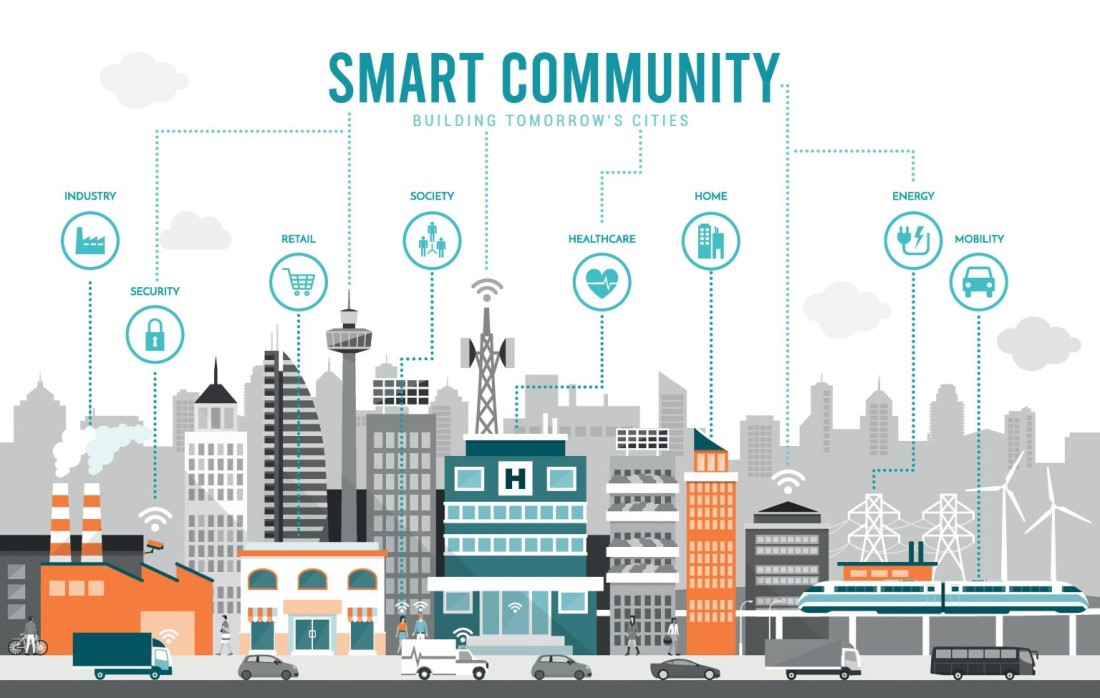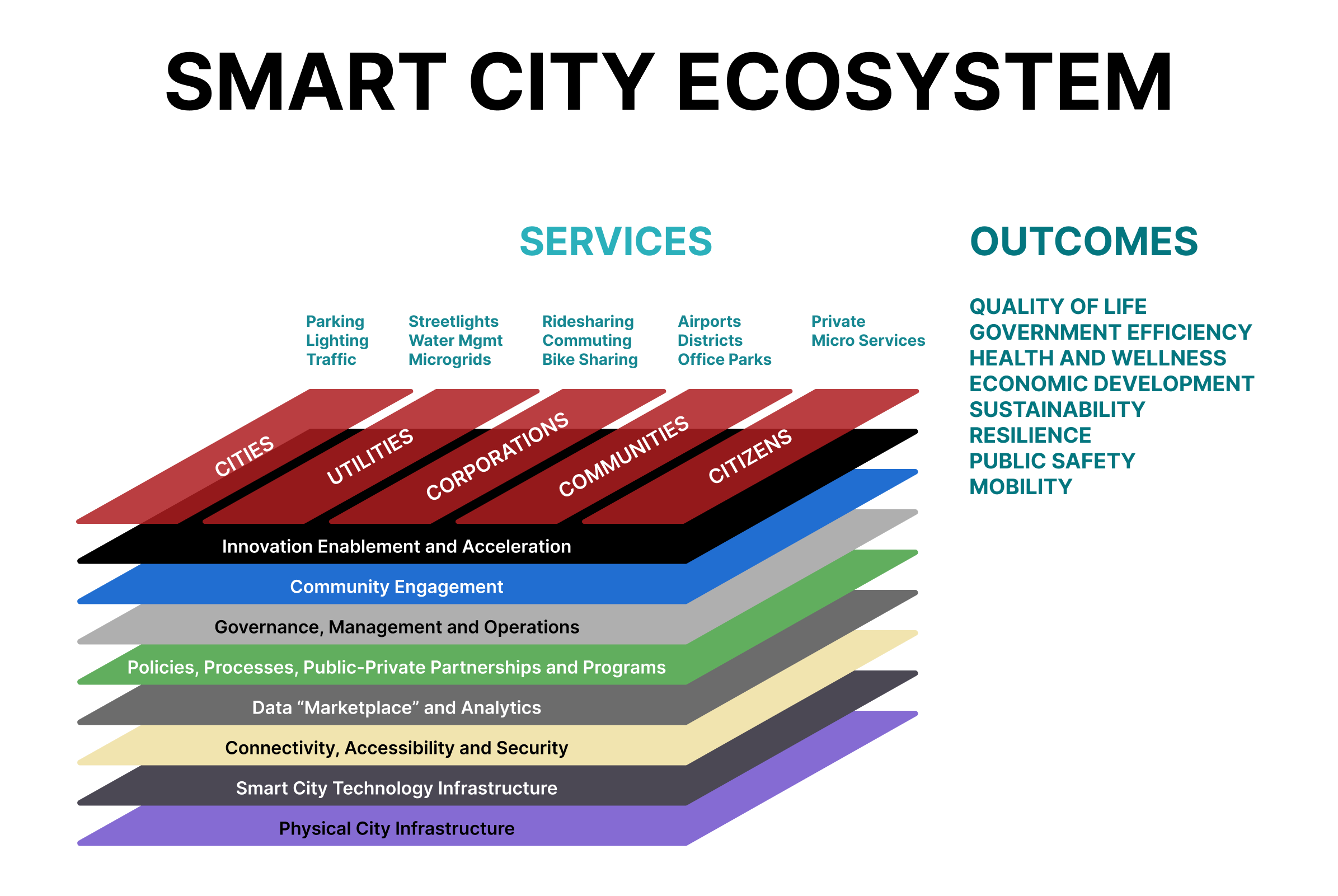Smart Communities in North Carolina
Smart community technologies can help local governments and communities in North Carolina do more with less, broaden community engagement, and improve service delivery.

Increasingly, if we encounter a civic need, there is an app for that. From online public engagement to smart parking apps to advanced water metering infrastructure, digital technologies, and data analytics are changing the nature of social connection and service delivery. If done right, smart city and smart community applications use technology to equitably improve the local quality of life (Hurtado, Hitchings, and Rouse 2021). Achieving this vision requires building a smart community “ecosystem” that includes network infrastructure such as high-speed internet to facilitate the flow of data, sensors and software applications to capture and analyze the data, and plans and policies to guide data use.
Smart community technologies can help local governments and communities in North Carolina do more with less, broaden community engagement, and improve service delivery. Some smart community applications use artificial intelligence, while others use more conventional algorithms. Moving more government and consumer functions online has been particularly important in the wake of the pandemic to increase public safety, ensure access, and improve convenience. Major institutional partners such as area universities and businesses hold the potential to share the costs of building a dynamic smart community ecosystem. Demonstrating value, identifying funding sources, and building cross-sector collaboration will be key priorities for advancing smart community development. Numerous and varied partners can help create a rich learning network of organizations that can pilot smart community tools and applications for testing, refinement, and use. Appropriate scaling of technologies will be key to serving small towns and larger communities. A great resource for communities across the state is the N.C. Division of Broadband and Digital Equity.
Potential Responses
Short-Term
- Inventory existing smart community initiatives in NC
- Create a regional smart communities learning network
- Identify smart communities funding
- Encourage the development of local smart communities pilot projects
- Expand access to broadband using NC broadband planning tools
Medium-Term
- Draft local smart community strategic plans
- Draft a regional smart community strategic plan
- Develop a digital inclusion plan using the NC template
- Develop a regional “pitch + pilot” program for smart community technologies
- Support smart community partnerships
- Scale up successful smart community pilot projects to community level
Long-Term
- Implement local smart community strategic plans
- Hold annual smart community showcase to feature projects
- Conduct local and regional smart community needs assessments to track progress
Key Stats
- One study found that communities just starting to pursue smart community projects made a Return on Investment of 2.6%, while smart community leaders achieved an ROI of 5.6% (ESI ThoughtLab 2019).
- The Orange Water and Sewer District’s (OWASA) “Agua Vista” advanced metering infrastructure (AMI) system alerted customers to about 10,000 water leaks in 2019 and was projected to have an ROI of 4.8% (Tiger 2020; Don Schlenger and Associates 2016).
- The U.S. smart cities market was valued at $271 billion in 2021 and is expected to grow at a compound annual growth rate (CAGR) of 21.6% from 2022 to 2030 (Grand View Research 2022).
- Smart buildings with integrated systems can save 30–50% of energy over an otherwise inefficient building (American Council for an Energy-Efficient Economy 2017).
 Credit: Cary Smart and Connected Communities initiative
Credit: Cary Smart and Connected Communities initiative
Example: Town of Cary Smart Communities Program
Riverine flooding is a problem throughout North Carolina. Advanced warnings can make all the difference in reducing the impacts on life and property. As a result, the Town of Cary worked with Microsoft and SAS to develop an Internet of Things (IoT) solution to help it track floods in real time. Now it is scaling up the solution and creating a grid of rain gauges throughout the community to provide real-time public information and help Cary stormwater and emergency management staff improve their situational awareness and deploy resources more rapidly to address flooding impacts. This is part of a larger Smart and Connected Communities initiative by the Town.
Click here to complete our survey about North Carolina drivers of change!
References
Carteret County, NC. Connecting Carteret: A Plan for Digital Inclusion. 2021.
Center for Digital Government. Digital Cities and Digital Counties award winners.
City of Chula Vista, CA. Digital Equity and Inclusion Plan. 2020.
City of Orlando, FL. Future-Ready City Master Plan. 2020.
City of Raleigh, NC. Strategy and Innovation Program.
Deloitte. The Challenge of Paying for Smart Cities Projects. 2018.
ESI ThoughtLab. Smart City Solutions for a Riskier World. 2021.
McKinsey Global Institute. Smart Cities: Digital Solutions for a More Livable Future. 2018.
N.C. Division of Broadband and Digital Equity. Website with Numerous Resources.
Person County, NC. Digital Inclusion Initiative.
Petra Hurtado, Benjamin G. Hitchings, and David C. Rouse. Smart Cities: Integrating Technology, Community, and Nature. PAS Report 599 (American Planning Association). 2021.
Town of Morrisville, NC. Connect Morrisville 2021-2024 Strategic Plan. 2021.


